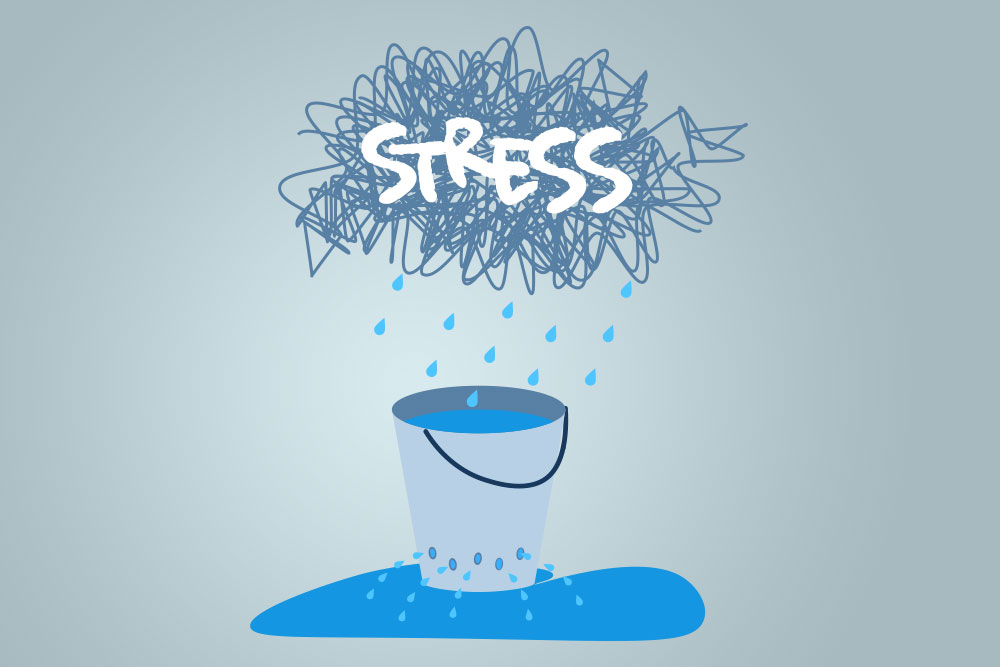
You need stress. Everyone does. The right amount of stress (and the hormone it creates) keeps us alert, focused and motivated.
The trick is taking on only what you can handle.
But you already knew that. However, you might need to learn how to use your inner stress bucket to manage stress levels.
You might not even know you have a stress bucket. But you do – a metaphorical one. And it might be the best stress-management tool you’re not using.
Read this guide to discover your stress bucket and what’s causing it to spill over. You’ll also learn a few coping techniques when it gets too much.
What is a Stress Bucket?
Imagine that the things causing you stress – work, finances, relationships, etc – are rain clouds over your head.
Now, picture a bucket in your hands. As the rain starts to pour, your bucket will fill up.
That’s the stress bucket. A way to visualise the stress that we carry, developed by Brabban and Turkington in 2002.
In an ideal world, we’d only ever face a light shower. The kind of stress that can motivate us or keep us focused. And our bucket would be manageable – not empty but easy to carry.
But the storm clouds roll in for everyone eventually. Losing a loved one, moving house, facing a severe illness – something will cause your bucket to overflow. And when you’re carrying more stress than you can safely handle, your mental and physical health are at risk.
Mental Health Courses
Our mental wellness courses help overcome the stigma associated with mental health challenges and provide practical techniques for managing such challenges in professional settings. The courses aim to protect employees’ mental well-being, improve productivity and enhance work and personal life balance.
What Fills up Your Stress Bucket
Both long-term and short-term stress fill your stress bucket. Stress can come from various sources in your life, including:
- Work, such as heavy workloads, conflicts and a lack of support
- Home, such as financial and relationship problems
- Health, such as illness or unhealthy lifestyle choices
- Thinking patterns, such as self-doubt and triggers from past events
- Daily hassles, such as commuting and sensory overload
- Life events, such as bereavement, separation or moving houses
Each of these stressors adds water to your bucket. A person’s capacity to contain stress is their stress threshold, which is the size of their stress bucket.
Finding the Size of Your Stress Bucket
Your stress bucket will be unique because we all experience stress differently.
Some of us can handle more stress than others. And this is reflected in the stress bucket concept. The size of your bucket represents how much stress you can take before it negatively impacts your health. So, some people’s buckets are bigger than others.
The amount of stress we can handle is determined by a few different factors, such as:
- Genes
- Personality
- Personal experiences
We also all have different susceptibilities to different types of stress. Something that is extremely stressful for one person might be only slightly stressful for another.
The key point to remember is that we all have a limited total capacity for stress.
What Happens When the Stress Bucket Overflows
If too much water pours into the bucket, it will start to overflow. When we experience too much stress at once, it can feel more than we can handle.
When this happens, even small problems begin to feel overwhelming, as there’s no capacity left for them. The experience may be different for different people, but some common signs include:
- Burnout
- Exhaustion
- Irritation
- Anxiety
- Changes in sleep and appetite
- Reduced concentration
When we feel like this, it’s important to try to release pressure through healthy coping methods.

How to Use the Stress Bucket to Manage Your Stress Levels
Your bucket has a limited capacity. And getting rid of every rain cloud over your head is out of your power. (It’s healthy to have a few different types of stress in your life.)
So, what can you do to manage your stress levels?
You need to add more taps to your bucket, allowing your stress to flow out of your bucket.
Taps
Taps are the things you do in life that reduce stress levels. These are going to be specific to you, but there are some widely recognised healthy coping strategies, such as:
- Socialising with friends and family
- Meditating
- Exercise
- Spending time on a hobby
- Sleeping well
- Asking for help
You probably already have a few of these ‘taps’ in your life. When things get difficult, you can open them up and let some stress drain out of your bucket to keep things manageable.
But if you’re finding your stress levels climbing too fast, too often, you need to add more taps to your bucket. However, you must ensure any coping strategies are healthy and sustainable.
False Taps
It’s easy to confuse a tap with a false tap.
A false tap might make you feel better in the short term, but it will only add to your stress levels in the long run. Imagine a tap that runs out of your bucket before looping back around and filling it up again. That’s a false tap.
Again, false taps are usually personal, but there are common ones to look out for, such as:
- Drug or alcohol abuse
- Oversleeping
- Procrastination
- Ignoring problems
- Refusing to talk about issues
These might offer temporary and immediate relief from stress, but will only worsen issues over time.
Why You Should Use The Stress Bucket Model
Visualising your stress bucket and the rain clouds filling it can help you identify what causes stress in your life.
It also helps you determine what a healthy stress level is for you. You’ll recognise when you can take on a little more or when it’s time to step back for your well-being.
The stress bucket concept also helps you identify the healthy strategies you already have in your life that reduce stress. And depending on what you need, you can use it to develop a few more techniques to help you balance the stress you carry daily.
Other Ways to Manage Stress
Stress buckets are just one tool to protect your mental health. But applying it to a professional setting where everyone’s different isn’t easy. A more formal system is needed to understand and manage workplace stress’s potential harm.
Our Stress Assessment Training teaches you how to evaluate and manage stress in the workplace. You’ll learn how to identify what causes stress in your professional environment and implement strategies that control and reduce stress levels for you and your colleagues. The course also covers how to support those already suffering from stress and helps create more open, productive workplaces where everyone can do their best work.





















